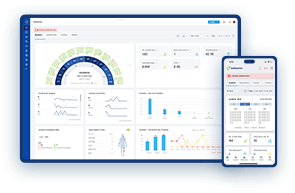
EHS Software Pricing: Factors That Impact the Cost
Finding the right EHS software at a price that fits your budget can be tricky. With safety budgets tightening, it’s crucial to make investments that enhance both operations and safety. How do you find the right EHS software at a price that fits your budget?
Several factors influence EHS software pricing, including company size, unique requirements, and preferences. The actual cost of the software significantly impacts purchase decisions, so it’s crucial to understand what you’re getting for your money. Choosing the cheapest option that doesn’t meet your needs can undermine your safety program. Let’s look at the key factors that influence pricing and how you can make an informed decision.
1. Number of User Licenses
Most EHS software is priced per user, so the number of licenses you need will significantly impact the cost. As your organization grows, licensing needs may change, so choosing a provider that offers flexible plans is important. Consider how often you may need to adjust the number of licenses, as some providers may charge extra for changes.
2. Feature-Rich Modules
Standalone systems for different safety functions can quickly become expensive. An integrated suite can often be more cost-effective, combining features into a unified platform and providing comprehensive safety management. However, ensure that the suite’s features align with your organization’s needs, as unnecessary modules can increase costs.
3. Implementation Strategy
The cost of implementing EHS software varies depending on the complexity of your setup and the level of training required. Software with intuitive design, easy onboarding, and accessible support can reduce implementation costs. An initial investment in training may seem costly but can significantly improve user adoption and reduce errors.
4. Hosting Plan
The choice between cloud-based and on-premise hosting directly affects pricing. Cloud-based solutions often have lower upfront costs but recurring subscription fees, whereas on-premise solutions require higher initial investments but offer more customization and control. Your organization’s data security requirements and compliance needs should guide this decision.
5. Scalability
As your business grows, your software must scale accordingly. Pricing can vary based on the scalability of the solution, with some providers charging more for advanced features or expanded data handling capabilities. Evaluate the potential for business growth to choose a solution that remains cost-effective over time.
6. Integration Capabilities
The ability of the EHS software to integrate with other systems, such as HR or ERP platforms, can affect pricing. More complex integrations may increase costs, so it’s crucial to understand your integration needs. Seamless integration reduces manual work and ensures consistent data, which can justify the extra cost.
7. Regulatory Compliance
Features that help maintain compliance can impact pricing, as they often require regular updates to keep up with changing regulations. The more robust and tailored the compliance features, the higher the potential cost. Be sure to align your software choice with the specific regulatory requirements of your industry.
8. Vendor Support and Maintenance Costs
Ongoing support and maintenance directly affect pricing. Annual fees can include technical support, software updates, and additional features, all contributing to the overall cost. Assess the support services available to ensure you’re getting value for your investment, especially if your team needs substantial assistance.
Understanding these factors can help you navigate EHS software pricing more effectively. By assessing your organization’s specific needs, you can identify the most suitable solution that aligns with your budget and safety goals.
Related read: Our listing of the best EHS software.
Ben Johnson is a dedicated Customer Success Executive at Safetymint. With a strong commitment to excellence, Ben works closely with customers to ensure they fully leverage the capabilities of Safetymint to its fullest potential, aiming to significantly reduce or mitigate safety risks and incidents.




